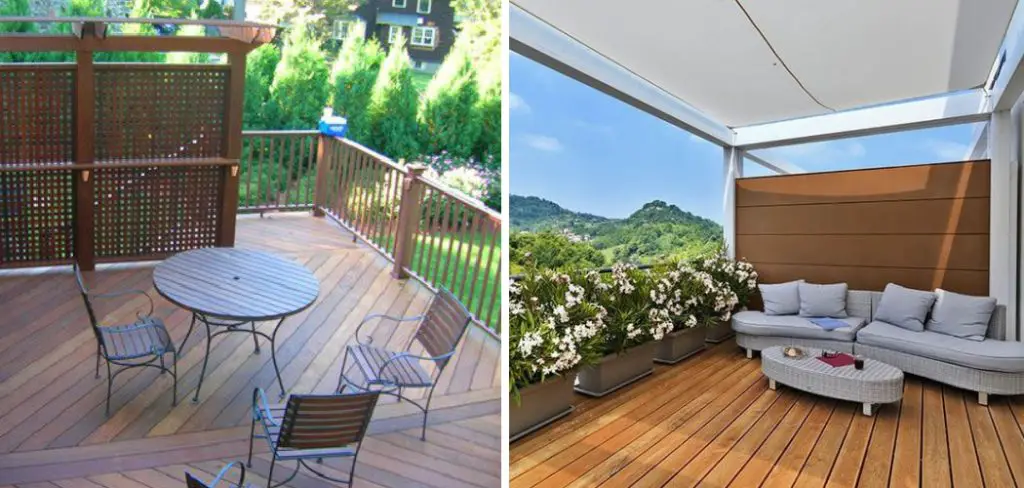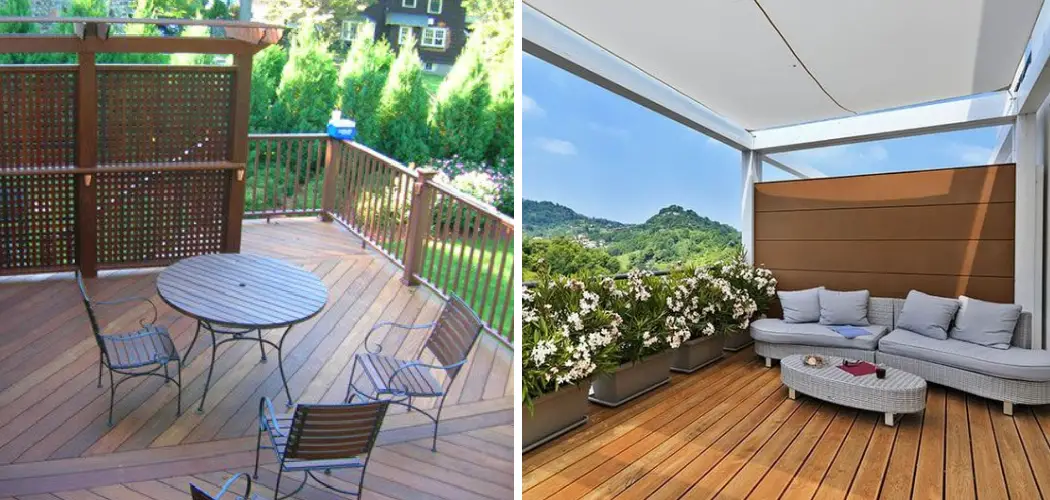Spending time on a deck or patio is a delightful way to embrace the outdoors, whether it’s for relaxation, social gatherings, or enjoying a meal. However, when strong winds gust through, it can significantly disrupt the experience and leave you feeling chilly and uncomfortable.

Fortunately, there are effective methods to block wind on the deck, allowing you to create a more pleasant and sheltered environment. In this article, we will explore various strategies and practical tips to help you how to block wind on deck, ensuring that you can fully enjoy your outdoor space even on windy days.
From utilizing windbreaks and installing screens to employing natural barriers and adjusting the deck layout, these techniques will enable you to create a cozy and protected space, allowing you to make the most of your outdoor living area regardless of the wind’s strength. Let’s dive in and discover how to transform your deck into a wind-resistant oasis of comfort.
The Importance of Creating a Comfortable Outdoor Environment
Creating a comfortable outdoor environment on your deck or patio is essential for enjoying the outdoors at any time of year. Strong winds can be particularly uncomfortable, making it difficult to relax or entertain guests. Blocking wind on deck with some simple steps can help create an enjoyable space and reduce the impact of unpredictable weather.
Not only will blocking wind make the area more pleasant, but it will also protect your furniture and décor from being damaged by strong gusts. With these tips and tricks, you can easily block wind on deck without breaking the bank.
The first step in creating an effective barrier against strong winds is to look at existing structures around the home that may provide some protection. Trees, shrubs, fencing or walls are all great options for blocking wind. If there are no existing structures in the area, adding some to create a physical barrier can be beneficial. Installing lattice or trellis panels around the deck is an attractive option that adds privacy as well as protection from strong gusts.

For decks and patios with wide open spaces, using sail-like fabrics can be a great way to block the wind. This type of fabric is designed to catch and disperse the wind, reducing its impact on the area. Installing poles around the perimeter of the deck and attaching fabric sheets or sails between them makes an attractive and effective barrier against strong gusts.
Does Lattice Block Wind?
The answer to this question is yes, lattice can block the wind. Lattice screens are designed to be used as a decorative solution for privacy and visual appeal in outdoor spaces. The open slats of the lattice design form an overlapping pattern that can act as an effective wind blocker when installed correctly.
It offers more airflow than solid paneling, but the overlapping design helps to reduce wind and keep it from becoming a nuisance. This makes lattice screens an effective option for blocking wind when used on decks or other outdoor spaces.
In addition to providing protection from wind, lattice can also help improve outdoor living by providing additional shade in the hot summer months. It is important to note, however, that lattice is not a guarantee against strong winds and can be easily damaged in especially windy conditions. If your area is prone to high winds or gusts, it may be necessary to supplement the lattice with additional wind-blocking materials such as solid wooden panels or metal fencing.

Overall, lattice screens can be an effective way to block wind and provide additional privacy on outdoor decks. However, it’s important to consider local climate conditions when deciding what type of wind-blocking materials are best for your space. If you’re looking for extra protection from strong winds and gusts, it may be necessary to supplement the lattice with other wind-blocking solutions.
10 Methods How to Block Wind on Deck
Method 1: Windbreak Walls or Fences
Installing windbreak walls or fences is an effective way to block wind on your deck. These structures act as physical barriers, diverting or reducing the force of the wind. Consider using materials such as wood, metal, or tempered glass to construct a solid windbreak that aligns with your deck’s aesthetic. As a bonus, windbreak walls can also provide privacy and shade to your outdoor space.
Method 2: Outdoor Curtains or Blinds
Outdoor curtains or blinds can provide both wind protection and privacy for your deck. Choose weather-resistant fabrics that can withstand outdoor conditions. Install the curtains or blinds along the sides of your deck, allowing you to adjust them as needed to block the wind while still allowing airflow.

If you’re feeling really ambitious, you can build a semi-permanent wind block by mounting the curtains or blinds on a piece of wood and attaching it to your deck’s railing. This will provide greater protection from the wind, as well as a degree of privacy for your deck.
Method 3: Retractable Awnings or Canopies
Retractable awnings or canopies offer a versatile solution for blocking wind on your deck. These structures can be extended or retracted depending on the weather conditions.
Opt for a high-quality, wind-resistant awning or canopy that can withstand gusts and provide a shaded and protected area. Ensure the awning is tightly secured to the deck, and that any canvas or fabric used is strong and UV-resistant.
Method 4: Portable Windbreak Panels
For a flexible option, consider using portable windbreak panels. These lightweight and easy-to-move panels can be strategically placed on your deck to create wind barriers where needed.
Choose panels made from durable materials such as aluminum or composite materials that can withstand outdoor elements. This type of windbreak can be moved around to create the most effective barriers on your deck, which makes it perfect for decks where furniture or other items are regularly moved.

Method 5: Outdoor Plants and Hedges
Utilize outdoor plants and hedges strategically to block wind on your deck. Planting tall, dense shrubs or trees around your deck can create a natural windbreak. Opt for varieties that are known for their wind-resistant properties, such as evergreen trees or shrubs with sturdy foliage. Be sure to place the plants close enough together that air flow is blocked, but far enough apart so that they have room for growth.
Method 6: Windproof Screens or Mesh
Windproof screens or mesh can be installed around the perimeter of your deck to block wind while still allowing air circulation. Look for screens specifically designed to withstand strong winds and UV exposure.
These screens can be attached to existing structures or used as freestanding panels. When installing screens, make sure that all edges are securely fastened and that the hardware used can withstand the elements.
Method 7: Adjustable Louvers or Slats
Consider installing adjustable louvers or slats on your deck to control the amount of wind that enters the space. These adjustable features allow you to customize the level of wind protection and ventilation.
Install the louvers or slats on the sides of your deck or on pergolas or trellises. Another option is to install them in window-like frames that can be adjusted as desired. Louvers and slats come in many styles, colors, and materials, offering a great variety of options to choose from.

Method 8: Deck Windbreak Extensions
If your deck has an existing railing, you can add windbreak extensions to increase protection from the wind. These extensions can be made from materials such as glass or polycarbonate sheets and can be attached securely to the existing railing.
If you choose to use glass, make sure that it is tempered or safety glass for added security. To further enhance your deck windbreak, you can place potted plants, lattice screens or other wind-blocking objects along the railing.
Method 9: Deck Enclosure or Sunroom
For complete wind protection, you can consider enclosing your deck with a dedicated deck enclosure or a sunroom. These structures provide insulation and complete shelter from the wind, allowing you to use your deck in all weather conditions.
Depending on the size, materials used, and design of the enclosure, they can also provide additional benefits, such as privacy from neighbors and a sound barrier.
Method 10: Deck Layout and Furniture Arrangement
The layout and arrangement of your deck can also help in blocking wind. Positioning taller furniture or decorative features strategically can act as natural windbreakers.
Arrange seating areas closer to the wind-resistant sides of the deck or create cozy corners with surrounding walls or fences. If you want to make use of the breezes, place your seating area slightly angled towards the prevailing wind direction, which will help reduce its intensity.
Some Common Mistakes to Avoid
1. Underestimating Wind Speed:
Wind speed on a deck can increase in intensity quickly, so it’s important to be prepared by using the right materials to block the wind. Don’t underestimate the power of the wind and assume it won’t be a problem; it can be surprisingly strong.
2. Not Accounting for Wind Direction:
Wind direction can change quickly, so it’s important to have a plan in place that can accommodate any changes in direction. If you’re using screening materials, make sure to secure them in place with straps or ties so they don’t move around in the wind.
3. Not Using Tough Materials:
It’s important to use tough and durable materials when blocking the wind on your deck. Cheap plastic or thin fabric screens won’t be able to withstand strong gusts of wind, so it’s better to invest in quality materials that will last longer and provide better protection from the elements.
Conclusion
Through thoughtful planning and the implementation of appropriate wind-blocking methods, you can enjoy your Decking with peace of mind and remain comfortable in any weather conditions. With an affordable yet effective wind-blocking setup, you can make sure that every day spent on your deck remains enjoyable as the gusty winds won’t be able to reach it.
In order to ensure you’re adequately blocking wind from reaching your deck or patio, consider building or buying strategically placed barriers such as picket fences and decorative lattice panels that will give an obstacle for wind to have to go around. Follow these simple instructions outlined in this blog post about how to block wind on deck and you’ll be able to get the job done with ease.


